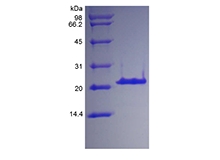| Official Full Name |
Recombinant Human Insulin-like Growth Factor-Binding Protein 3 (rHuIGF-BP3) |
| Squence |
 |
| Amino Acid Sequence |
GASSAGLGPV VRCEPCDARA LAQCAPPPAV CAELVREPGC GCCLTCALSE GQPCGIYTER CGSGLRCQPS PDEARPLQAL LDGRGLCVNA SAVSRLRAYL LPAPPAPGNA SESEEDRSAG SVESPSVSST HRVSDPKFHP LHSKIIIIKK GHAKDSQRYK VDYESQSTDT QNFSSESKRE TEYGPCRREM EDTLNHLKFL NVLSPRGVHI PNCDKKGFYK KKQCRPSKGR KRGFCWCVDK YGQPLPGYTT KGKEDVHCYS MQSK |
| Synonyms |
Growth-hormone-dependant Binding Protein, IBP-3, IGF-binding protein 3 |
| Accession Number |
P17936 |
| GeneID |
3486 |
| Summary |
Insulin-like Growth Factor-Binding Protein 3 (IGF-BP3) belongs to the IGFBP family, which are all cysteinerich proteins with conserved cysteine and have an IGFBP domain and a thyroglobulin type-I domain. Mature human IGF-BP3 contains 264 a.a. with three potential N-linked and two potential O-linked glycosylation sites. It is expressed by most tissues and has higher levels during extrauterine life and peak during puberty. The expression of IGF-BP3 in fibroblasts is stimulated by mitogenic growth factors such as Bombesin, Vasopressin, PDGF, and EGF. The protein forms a ternary complex with IGF-I or II and acid-labile subunit. In this form, it circulates in the plasma, prolonging the half-life of IGFs and altering their interaction with cell surface receptors. Decreased plasma levels of IGF-BP3 often happen during the progression of prostate cancer from benign to metastatic disease. |
| Source |
Escherichia coli. |
| Molecular Weight |
Approximately 28.8 kDa, a single non-glycosylated polypeptide chain containing 264 amino acids. |
| Biological Activity |
Fully biologically active when compared to standard. The ED50 as determined by inhibiting IGF-II induced proliferation of serum free human MCF-7 cells is less than 200 ng/ml, corresponding to a specific activity of > 5.0 × 103 IU/mg in the presence of 15 ng/ml of rHuIGF-II. |
| Appearance |
Sterile filtered white lyophilized (freeze-dried) powder. |
| Formulation |
Lyophilized from a 0.2 um filtered concentrated solution in PBS, pH 7.4. |
| Endotoxin |
Less than 1 EU/ug of rHuIGF-BP3 as determined by LAL method. |
| Reconstitution |
We recommend that this vial be briefly centrifuged prior to opening to bring the contents to the bottom. Reconstitute in sterile distilled water or aqueous buffer containing 0.1 % BSA to a concentration of 0.1-1.0 mg/mL. Stock solutions should be apportioned into working aliquots and stored at ≤ -20 °C. Further dilutions should be made in appropriate buffered solutions. |
| Stability and Storage |
Use a manual defrost freezer and avoid repeated freeze-thaw cycles.- 12 months from date of receipt, -20 to -70 °C as supplied.- 1 month, 2 to 8 °C under sterile conditions after reconstitution.- 3 months, -20 to -70 °C under sterile conditions after reconstitution. |
| References |
|
| SDS-PAGE |
 |
| Safety Data Sheet (SDS) Download |
Click to download |
| Technical Data Sheet (TDS) Download |
Click to download |



